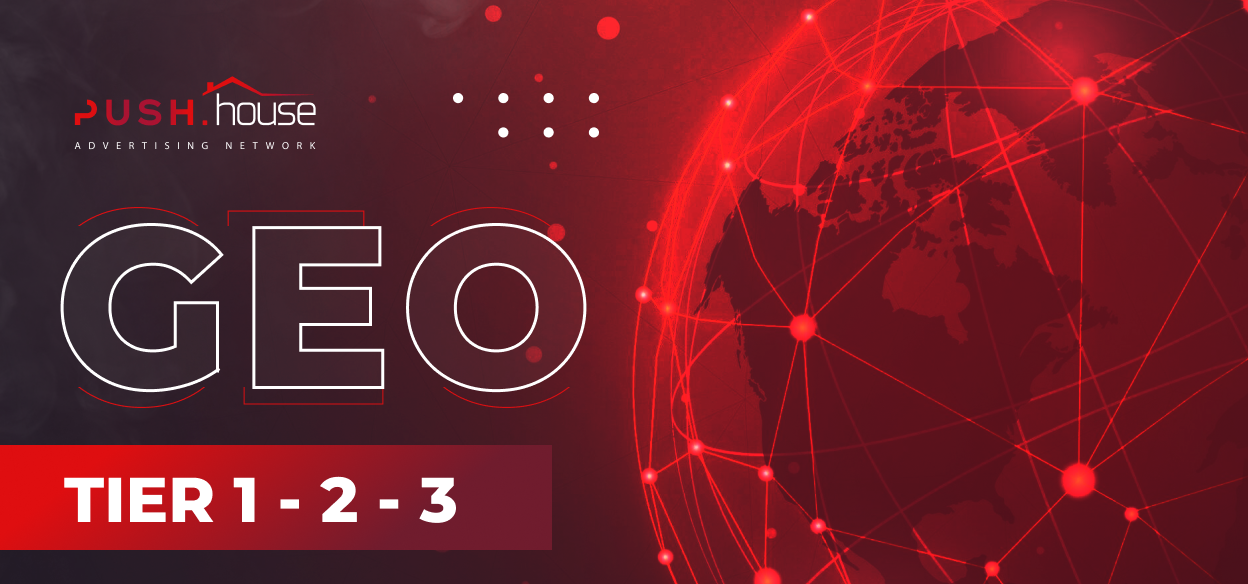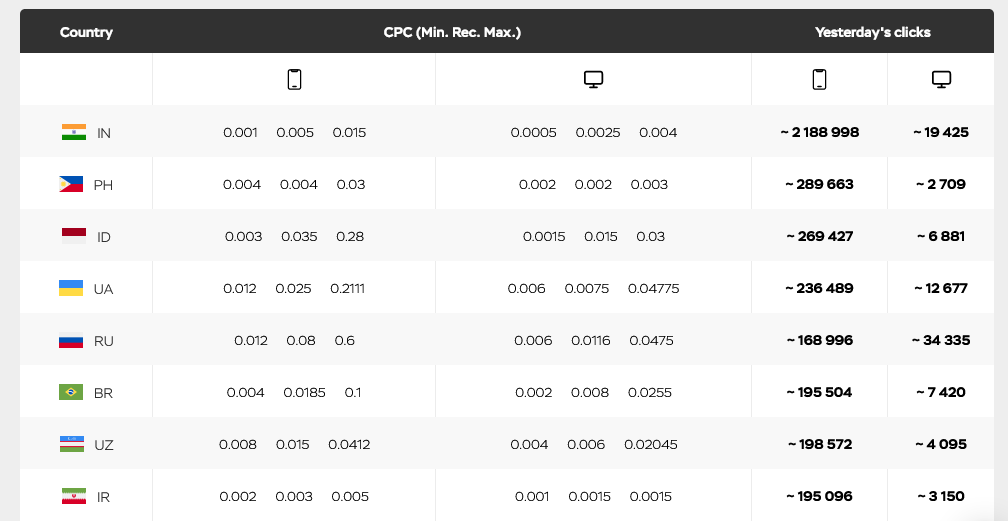
Geo in Affiliate Marketing: What Tier is
Hey there! This is Push.House.
Advertisers using Push.House can effectively promote offers across all popular verticals in more than 185 countries worldwide. Each country has unique features, including the living standard, population, average income, internet engagement, and much more. Understanding these differences is crucial to determining which region suits the advertising of a particular offer. This time, we’ll delve into what geolocation (GEO) means in affiliate marketing, what influences the choice of an advertising region, and what Tier stands for.
Let’s get started!
Geo in Affiliate Marketing
Geo in Affiliate Marketing refers to the region where the offer is planned to be promoted. The choice directly impacts the launch specifics, marketing strategy, and prospects for future profit. GEO is one of the most critical settings for your upcoming ad campaign. It not only determines countries but also cities and regions from where your traffic will be directed to your offers.
Each country has a wide range of distinctive features. Depending on these, the average cost of traffic in a specific region may differ from the market average or the maximum in another country.
The higher the standard of living in a region, the higher the rates that affiliate networks offer for successfully advertising an offer. The economic equation is simple here: more investment → more income.
Studying each region individually to understand its characteristics is inconvenient. Considering that some countries share similar characteristics, CPA marketers categorize them into several Tiers, as affiliate marketing experts refer to them.
What Tier is
Tier is a separate category comprising countries and regions with similar characteristics and features. The primary criteria for assessing distribution include solvency, standard of living, average income, internet spread, and demographic traits.
Interestingly, countries within a specific category can move up or down the list depending on the economic state within the region. Currently, there are four main Tier categories identified:
Tier-1
The “premium” category encompasses highly developed countries with a high standard of living and purchasing power.
- Australia
- Austria
- United Kingdom
- Belgium
- Germany
- Denmark
- Italy
- Iceland
- Spain
- Ireland
- Canada
- Netherlands
- New Zealand
- Norway
- Poland
- Portugal
- Slovenia
- United States of America
- Finland
- France
- Czech Republic
- Sweden
- Switzerland
Tier-1 countries stand out with the highest market rates and a wide range of offers. However, such reputation and advertisers’ pursuit of high payouts create significant market competition. The audience in these countries demands higher-quality promotional materials and the most engaging schemes. Otherwise, the risk of users skipping your ad offer increases.
Advantages of Tier-1:
- Most solvent audience
- Highest rates
- Wide range of offers
- Diverse payment models
Disadvantages of Tier-1:
- High traffic cost
- High entry barrier
- High competition
- Demanding audience
- Overall traffic volumes may be lower than some other Tiers
Tier-2
Tier-2 countries boast high-income levels and a stable economic situation, yet upon detailed analysis, they may lag behind regions in the first category. There are several reasons for this difference.
Firstly, most Tier-2 countries have major metropolitan cities where the primary solvent part of the population resides. Remote regions, however, significantly differ not only in standard of living but also in internet development.
Secondly, the classification of countries heavily relies on user engagement in online purchases. Despite technological progress, online shopping is less advanced in these countries. However, the Tier-2 GEO audience actively engages with online offers, positively affecting the prospects of advertising all popular verticals.
Tier-2 countries:
- Andorra
- Argentina
- Bahamas
- Belarus
- Bulgaria
- Bolivia
- Bosnia and Herzegovina
- Brazil
- Brunei
- Vanuatu
- Hungary
- Guyana
- Hong Kong
- Greece
- Dominican Republic
- Israel
- Indonesia
- Iceland
- Kazakhstan
- Qatar
- Cyprus
- China
- Colombia
- Costa Rica
- Latvia
- Lithuania
- Macau
- Malaysia
- Malta
- Morocco
- Mexico
- Nepal
- UAE
- Oman
- Panama
- Paraguay
- Peru
- Puerto Rico
- South Korea
- Russian Federation
- Romania
- Saudi Arabia
- Serbia
- Singapore
- Slovakia
- Slovenia
- Thailand
- Turkey
- Uruguay
- Fiji
- Philippines
- Croatia
- Montenegro
- Chile
- Ecuador
- Estonia
- South Africa
- Japan
Payouts in Tier-2 regions are slightly lower, and advertising requires a more detailed analysis of audience traits, mentality, and strict adherence to language specifics.
Advantages of Tier-2:
- High purchasing tendency
- Stable payouts
- Average market traffic cost
- Competitive environment
- Promising traffic volumes
Disadvantages of Tier-2:
- Detailed analysis of region traits is needed
- Localization of promotional materials and landing pages
- Approach specifics depend on national mentality
Contact the Push.House manager to get started
Tier-3
The third category includes regions with the lowest purchasing power. However, Tier-3 countries offer advertisers the largest volumes of potential traffic. Low purchasing power doesn’t imply a lack of interest in advertised goods or services. In this case, the approach to promotion must be more detailed, and the scheme should consist of several stages to stir user interest.
Among the peculiarities of the third category is the necessity for creatives launched in specific countries to be composed in the local language. Unlike other countries where English creatives convert as well as local language creatives, the low education level in Tier-3 countries limits advertisers’ approaches.
However, these minor drawbacks are compensated by the fact that the cost of traffic in these countries is one of the lowest. The “more traffic → more profit” strategy is the most effective in this case.
Tier-3 countries:
- Azerbaijan
- Albania
- Algeria
- Angola
- Armenia
- Bangladesh
- Barbados
- Bahrain
- Belize
- Benin
- Botswana
- Burundi
- Vietnam
- Gabon
- Guatemala
- Honduras
- Georgia
- Egypt
- Zambia
- India
- Jordan
- Iraq
- Cape Verde
- Cambodia
- Cameroon
- Kenya
- Comoros
- Congo
- Kuwait
- Kyrgyzstan
- Laos
- Lesotho
- Lebanon
- Mauritius
- Madagascar
- North Macedonia
- Mali
- Mozambique
- Moldova
- Mongolia
- Namibia
- Nigeria
- Nicaragua
- Pakistan
- El Salvador
- Eswatini
- Senegal
- Suriname
- Tajikistan
- Tanzania
- Trinidad and Tobago
- Tunisia
- Turkmenistan
- Uganda
- Ukraine
- Uzbekistan
- Sri Lanka
- Ethiopia
- Jamaica
The audience in Tier-3 countries is less sophisticated and is less accustomed to banner blindness. With a practical approach and strict adherence to advertising material creation rules, achieving profit in this region is more than possible.
When choosing the vertical and offer, ensure beforehand that the region supports delivery or has access to payment systems necessary for the target action and use of the offer.
Advantages of Tier-3:
- Lowest traffic cost
- Large traffic volumes
- Low competition
- Low entry barrier
- Absence of banner blindness
Disadvantages of Tier-3:
- Not very high payouts
- Need for deep analysis of the region’s target audience
- Localization of promotional materials and landing pages
- Lower purchasing power of the audience
- Possibility of some payment systems and delivery services not being supported
Tier-4
The fourth category of countries is considered the most unstable. Tier-4 includes countries with unstable political situations, low purchasing power, and internet spread. Most such countries are sparsely populated and lack serious prospects for effective offer promotion.
Tier-4 countries:
- Afghanistan
- Burkina Faso
- Haiti
- Iran
- Cuba
- Mauritania
- Malawi
- Niger
- North Korea
- Syria
- Sudan
- Togo
- Chad
- Equatorial Guinea
Choosing GEO
When choosing GEO, understand that the higher the click price, the greater the potential payout for a successful target action. However, high rates are not a reason to select only Tier-1 countries for advertising. As mentioned, competition is higher here, and the audience is more demanding.
Profit can be achieved in any GEO. Finding the right approach is essential. For beginners, we recommend starting with Tier-2 and 3 countries. The purchasing power of most regions in these categories is stable, allowing effective advertising of offers across most verticals.
Once the approach used in the region is maximally optimized, and the campaign is consistently profitable, consider looking at GEOs with similar mentalities and scaling the advertising campaign.
Much will depend on the advertising budget you allocate for promotion. To forecast advertising costs, navigate to the “Network Volume” tab.

Information about click prices in specific regions with minimum, recommended, and maximum rates is provided here.
Tips for Choosing GEO
- Base your decisions on the advertising budget. With Push networks, the principle is more traffic → more conversions. Study the market and predict which GEO aligns better with your advertising budget. Begin campaign setup based on this data, prepare creatives, and launch.
While advertising, you can constantly adjust the proposed rate. Use Push.House’s unique micro-bidding feature for this purpose. Learn more about it here.
- Don’t mix traffic. Stable results are achievable only when the promotion regions correspond to separate campaigns. Avoid mixing traffic and create new advertising campaigns for a new region.
- Study the region before launching. Don’t base your decisions solely on the rates offered by affiliate networks. Choose one GEO, study its features and the needs of its population. Then, localize creatives, pre-landings, and landing pages, and remember to consider time zones.
Contact our support managers if you encounter any difficulties or questions during the launch. We’ll resolve them in the shortest time possible.
Best of luck!








